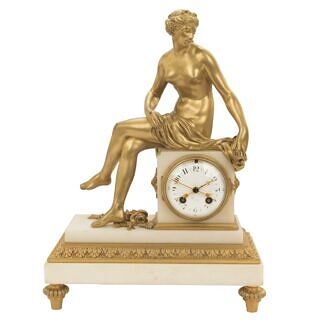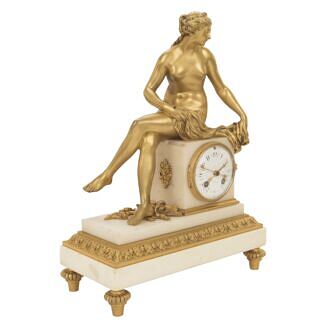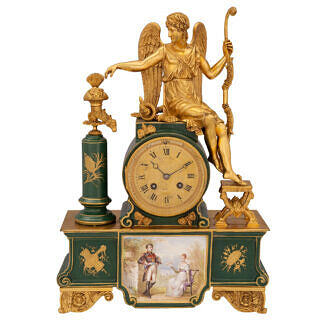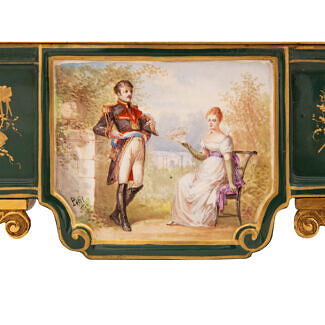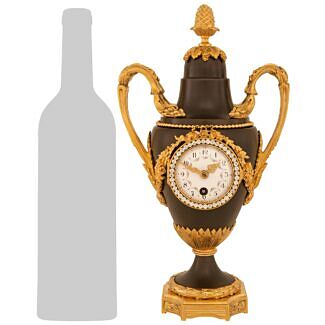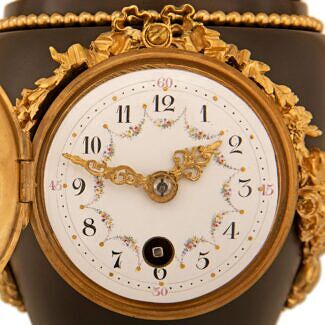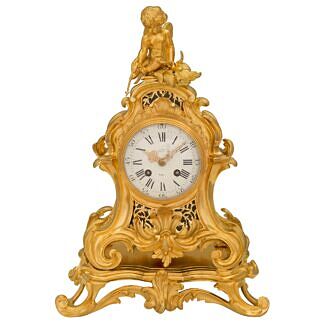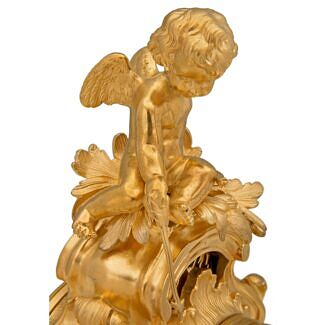A French 19th century Belle Époque period Louis XVI st. patinated Bronze, Ormolu, and Rouge Griotte marble clock
A lovely and high quality French 19th century Belle Époque period Louis XVI st. patinated Bronze, Ormolu, and Rouge Griotte marble clock, signed Falconet. This stunning miniature timepiece is raised by a mottled edge circular Rouge Griotte marble base accented... — Read More
A lovely and high quality French 19th century Belle Époque period Louis XVI st. patinated Bronze, Ormolu, and Rouge Griotte marble clock, signed Falconet. This stunning miniature timepiece is raised by a mottled edge circular Rouge Griotte marble base accented with a beaded Ormolu band. Atop the marble base is an Ormolu landscape with a patinated Bronze winged cherub on one leg standing above. This joyful cherub is tastefully designed with Ormolu hair and an Ormolu framed clock created to look like a drum, all while harmoniously playing the trumpet. The enameled dial of the clock that imitates a drum contains pierced Ormolu hands and swaging colorful foliate garlands between each hour numeral. — Read Less
- Item # 13864
-
H: 8.5 in L: 5.25 in D: 6 in
H: 22 cm L: 13 cm D: 15 cm
- France
- 19th Century
- Marble/Stone, Ormolu, Patinated Bronze
-
Belle Époque Period Read More,
Louis XVI st. Read More
(Belle Époque Period) -
Gaining its name from the optimistic and peaceful period of time between 1871 and World War I, Belle Epoque means “beautiful period”, and occurred during the era of the Third French Republic. This period of economic, colonial, and scientific prosperity brought with it a flourishing artistic climate with numerous literal, musical, theatrical, and visual masterpieces being created.
The Eiffel Tower, which was constructed between 1887 and 1889, served as the entrance to the World’s Fair held in Paris. That same year, the Moulin Rouge cabaret in Paris was founded and showcased the now more mainstream styles of performance including can-can dancing. Belle Epoque dancers and singers were Paris celebrities and became immortalized by the poster arts of Toulouse-Lautrec.
Leading up to this period in 1865, the American Civil War was coming to a close, with France proposing to construct the Statue of Liberty as a joint effort with the United States. France would be responsible for the statue, with America constructing the pedestal. Created to celebrate the nation’s success in building a viable democracy, the statue would stand as a symbol of friendship between the French and American people.
(Louis XVI st.) -
Also known as Louis Seize, Louis XVI's style is a style of architecture, furniture, decoration, and art created during Louis XVI’s 19-year reign in France, just before the French Revolution.
Thought to be a reaction and juxtaposition to the prior more elaborate styles, Louis XVI style developed at the end of the Baroque Period and continued until the birth of French Neoclassicism.
King Louis XVI showed little enthusiasm for the old world styles of the Baroque Period and he sought out a create a new “beau ideal” that focused on the purity and grandeur of Ancient Romans and Greeks.
Inspired by Ancient Roman architecture and art, distinct features of the Louis XVI style are linear lines, small repeated motifs, floral medallions hanging from ribbons, acanthus leaves, urns, dolphins, ram, and lion heads, and griffins.
Greco-Roman elements, often used in earlier and later French styles, were also quick common and included fluted and twisted columns, Caryathids, and corbels.
- Étienne Maurice Falconet Read More
Étienne Maurice Falconet (1 December 1716 – 24 January 1791) is counted among the first rank of French Rococo sculptors, whose patron was Madame de Pompadour. Falconet came to prominent public attention in the Salons of 1755 and 1757 with his marble statues of L’Amour and the Nymphe descendant au bain (also called "The Bather"), which is now at the Louvre. In 1757 Falconet was appointed director of the sculpture atelier of the new Manufacture Royale de Porcelaine at Sèvres.
He remained at the Sèvres post until he was invited to Russia by Catherine the Great in September 1766. At St Petersburg he executed a colossal statue of Peter the Great in bronze, known as the Bronze Horseman, together with his pupil and stepdaughter Marie-Anne Collot. In 1788, back in Paris he became director of the Académie des beaux-arts. Many of Falconet's religious works, commissioned for churches, were destroyed at the time of the French Revolution
Payment Plan Option Learn More Choose the payment plan option at checkout and customize this payment option with our team. Payment plans are flexible and items will ship once all payments are received.
























